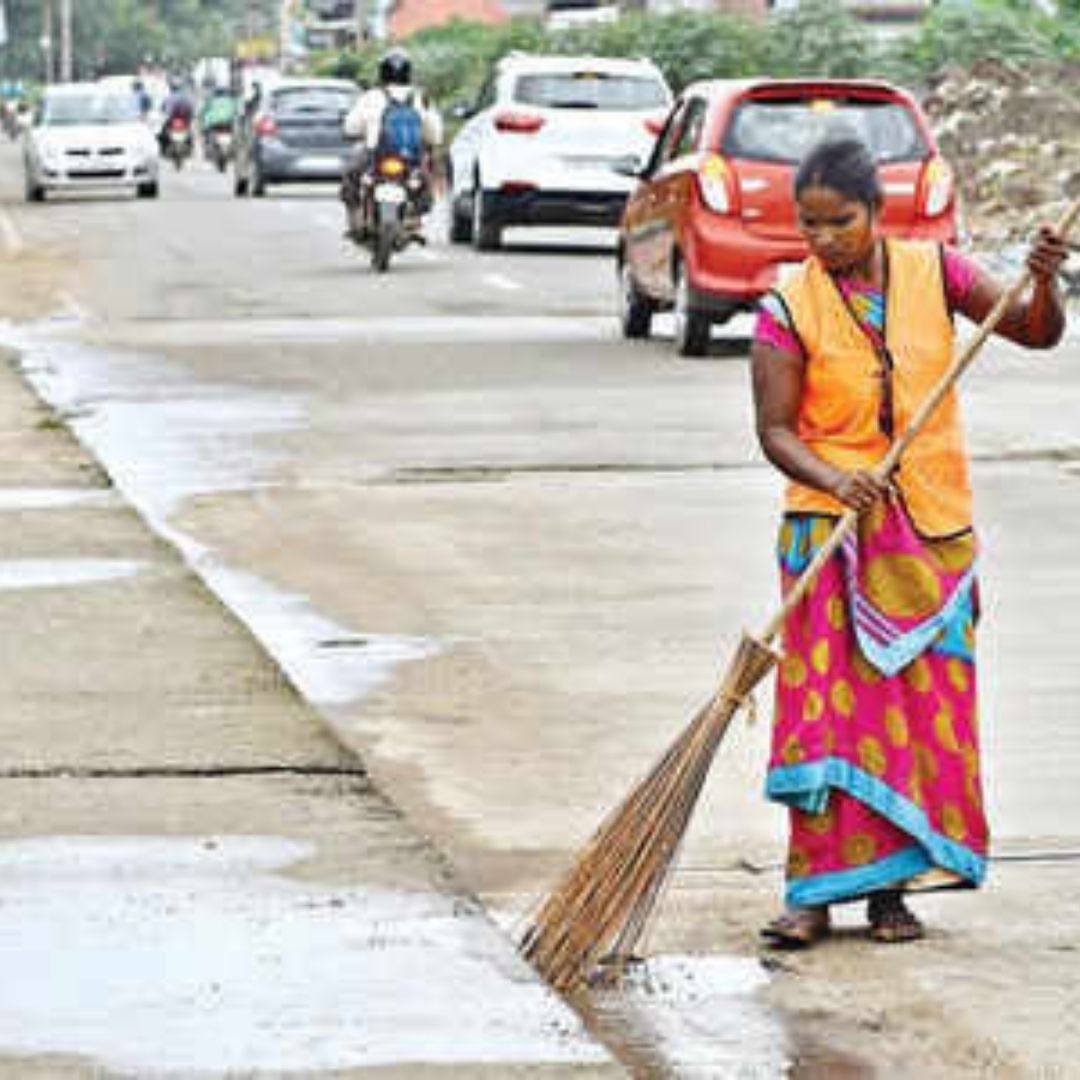
Image Credits: The Times Of India
'Invisible And Discriminated': The Plight Of Women Sanitation Workers Making Bharat Swachh
India, 27 Aug 2021 9:54 AM GMT | Updated 31 Aug 2021 11:38 AM GMT
Editor : Palak Agrawal |
Palak a journalism graduate believes in simplifying the complicated and writing about the extraordinary lives of ordinary people. She calls herself a " hodophile" or in layman words- a person who loves to travel.
Creatives : Tashafi Nazir
For most people, journalism sounds hectic and chaotic. For her, it's a passion she has been chasing for years. With an extensive media background, Tashafi believes in putting efforts on presenting a simple incident in the most interesting way.
"Garib ka zindagi hai, kamaenge toh khaenge, nahin toh bhuke marenge (This is the life of the poor. If you earn, you eat, or else you die of hunger)," said one woman sanitation worker from Muzaffapur.
Maya Bai is a resident and sanitation worker with the Ganj Basoda Nagar Palika Parishad in Madhya Pradesh. She has been employed by the urban local body for 35 years now.
Maya Bai's group is responsible for the cleaning and upkeep of ward 22, Chud Mohalla of the city. An ordinary sanitation worker, she faced an extraordinary situation when the COVID-19 pandemic struck the city, especially when the first case was detected in her ward.
In a matter of two weeks, the area was declared a containment zone. No one was allowed to enter the area, but the daily cleaning of the community toilet in the ward was a basic necessity.
When no other sanitation worker was ready to take up the job, Maya Bai showed immense courage and volunteered for the task. At this crucial point, she accepted the challenge and cleaned the area single-handedly in order to ensure the safety of its residents, although putting her own life at risk.
Ground-level sanitation workers form the backbone of the public hygiene and waste management system in India. They are the real champions behind the country's accelerated sanitation coverage, who painstakingly make sure that the daily waste is being treated safely and the cities stay clean. Despite providing an essential public service, their work often goes unnoticed.
On a daily basis, more than five million sanitation workers in the country put their lives at risk and ensure people have access to fully functioning sanitation services even during a crisis. However, their constant efforts remain unrecognised. These workers are often ostracised and are at the bottom of the social and economic ladder, facing marginalisation because of their caste in several cases and, ironically, because of the very profession they are in.
The risks are even higher for the informal workforce. But women, who make up more than 80 per cent of waste pickers and 50 per cent of urban sanitation workers, are especially vulnerable because of their gender.
The World Health Organisation (WHO) refers to sanitation as "the provision of facilities and services for safe disposal of human urine and faeces".
Shakuntala Devi, a permanent sanitation worker employed with the Municipal Corporation of Muzaffarpur says, "Sehar mein do tarah ke log rehte hain. Kachra paida karne wale aur kachra saaf karne waale. Par sehari swacchta sirf nagar nigam ki jimmedari nahin hai. Aam logon ko bhi apna kaam thik se karna chahiye. Unko kachra idhar udhar nahin phenkna chahiye (There are two kinds of people in every city. The ones who generate garbage and the ones who clean it. However, the responsibility of keeping a city clean is not solely that of a municipal corporation. The general public should also do their part of the work properly. They should not litter public spaces mindlessly)."
As per the officials, there is a paucity of data pertaining to women sanitation workers. This is the result of a lack of overall information on informal sanitation workers (men and women) as well as segregated gender-based data on such workers. However, data plays a crucial role in understanding the intensity of the issue devising plans to improve the situation.
Health Risks Associated With The Job
"Though there is limited data, it appears that as the sanitation work gets more informal, the percentage of women tends to rise. This has to be seen in the context of a wide range of roles of sanitation workers (toilet cleaners, De-sludging operators, sewer cleaners, treatment facility workers, railway track cleaners, SWM workers, rag pickers, etc) across various contractual agreements – ULB payroll, contracted by ULB, private employment or daily wage earners. More informal the nature of work, fewer benefits are available," Kavita Wankhade, Head – Practice at the Indian Institute for Human Settlements, told The Logical Indian.
Wankhade is also a member of the National Faecel Sludge and Septage Management (NFSSM) Alliance.
"Women who are employed in daily wage work like cleaning toilets, etc are likely to be more vulnerable," she added.
While women sanitation workers are exposed to similar risks as their male counterparts, there may be an additional risk due to the design of protective equipment and tools that are not well-suited to their bodies.
"In addition, they may lack access to their entitlements – such as maternity leave, other leave benefits, insurance, adequate remuneration, protection from social and professional stigma, and lack of access to upskilling," Wankhade pointed out.
During menstruation, every month, women are subjected to frequent rashes, infections, and bruises on their thighs due to a tiring work schedule and walking miles, besides lack of proper toilet facilities. As most of the workers belonging to this group come from poor backgrounds and conservative families, the stigma surrounding the process makes it even worse.
Most of these women fail to express their predicament to their seniors and always hesitate to ask for leave during periods.
Several health checkups have been conducted for women sanitation workers from time to time across the country and it was observed that a majority suffered from joint pains, especially the elder women.
Conditions such as haemorrhoids, contact dermatitis, poor appetite, low or high blood pressure are common among the workers. Pushing heavy vehicles throughout the day results in long-term consequences, and the problems compound with the increasing age.
Gender Discrimination
While this section in India is often suppressed and neglected, inter-state disparities show differing discrimination based on rigid histories of gender discrimination.
Women sanitation workers live in a country that is still sunk in patriarchy and imposes a double burden of labour on lower caste women who have to work to survive.
The unhappy kinship of gender, caste, and occupation makes them the most unsafe worker among the others. Most of them are employed as contractual and outsourced workers, according to a recent study on women sanitation workers.
Working as contractual workers restate experiences of fear, danger, insufficiency. Those employed on daily wages fear losing their jobs should they take a day off. "Garib ka zindagi hai, kamaenge toh khaenge, nahin toh bhuke marenge (This is the life of the poor. If you earn, you eat, or else you die of hunger)," said one woman sanitation worker from Muzaffapur.
"Subah khana hota tha toh shaam ko nahi (If there was food in the morning, then there was none in the evening)," said another worker in Jhansi. Women sanitation workers must earn, or starve.
Initiatives Taken By The Government
The government has undertaken various initiatives through policies, schemes, laws, and programs to ensure a safe and sound environment and dignity to the sanitation workforce.
The Swachh Bharat Mission focused on ensuring a dignified and safer source of livelihood for sanitation workers by integrating them into the formal workforce through a convergence scheme with the National Urban Livelihood Mission (NULM).
For the very first time, the country witnessed women and transgender sanitation workers in the states of Odisha and Tamil Nadu paving the path and taking on roles that were men-dominated such as cesspool vehicle operations and septage treatment plant management.
Experts say that it is the citizens who need to change their perceptions about sanitation workers who are generally regarded as second-class citizens and acknowledge their invaluable contribution in making Bharat Swachh.
Also Read: Breaking The Glass Ceiling: 20-Year-Old Woman Becomes North Kashmir's Youngest Female Radio Jockey
 All section
All section














